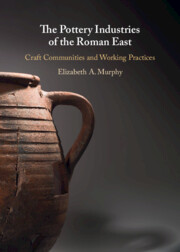Book contents
- The Pottery Industries of the Roman East
- The Pottery Industries of the Roman East
- Copyright page
- Dedication
- Contents
- Figures
- Tables
- Acknowledgments
- Abbreviations
- Chapter One Introduction
- Chapter Two Workshops: Models versus Practice
- Chapter Three Process, People, and Working Conditions
- Chapter Four Cultural Practices and Ritual Lives of Potters in the Workshop
- Chapter Five Potting Traditions, Craft Learning, and Product Innovation
- Chapter Six Socially Embedded Technologies and Local Technological Styles
- Chapter Seven Internal Social Dynamics of Industry Clusters: Cooperation and Competition
- Chapter Eight Urban Industry, Topographies, and Community Relations
- Chapter Nine Crafting Communities: Some Final Thoughts on the Social Experience of Roman Workshops
- Glossary of Specialized Potting Terms
- Bibliography
- Index
- References
Bibliography
Published online by Cambridge University Press: 20 March 2025
- The Pottery Industries of the Roman East
- The Pottery Industries of the Roman East
- Copyright page
- Dedication
- Contents
- Figures
- Tables
- Acknowledgments
- Abbreviations
- Chapter One Introduction
- Chapter Two Workshops: Models versus Practice
- Chapter Three Process, People, and Working Conditions
- Chapter Four Cultural Practices and Ritual Lives of Potters in the Workshop
- Chapter Five Potting Traditions, Craft Learning, and Product Innovation
- Chapter Six Socially Embedded Technologies and Local Technological Styles
- Chapter Seven Internal Social Dynamics of Industry Clusters: Cooperation and Competition
- Chapter Eight Urban Industry, Topographies, and Community Relations
- Chapter Nine Crafting Communities: Some Final Thoughts on the Social Experience of Roman Workshops
- Glossary of Specialized Potting Terms
- Bibliography
- Index
- References
- Type
- Chapter
- Information
- The Pottery Industries of the Roman EastCraft Communities and Working Practices, pp. 203 - 236Publisher: Cambridge University PressPrint publication year: 2025

